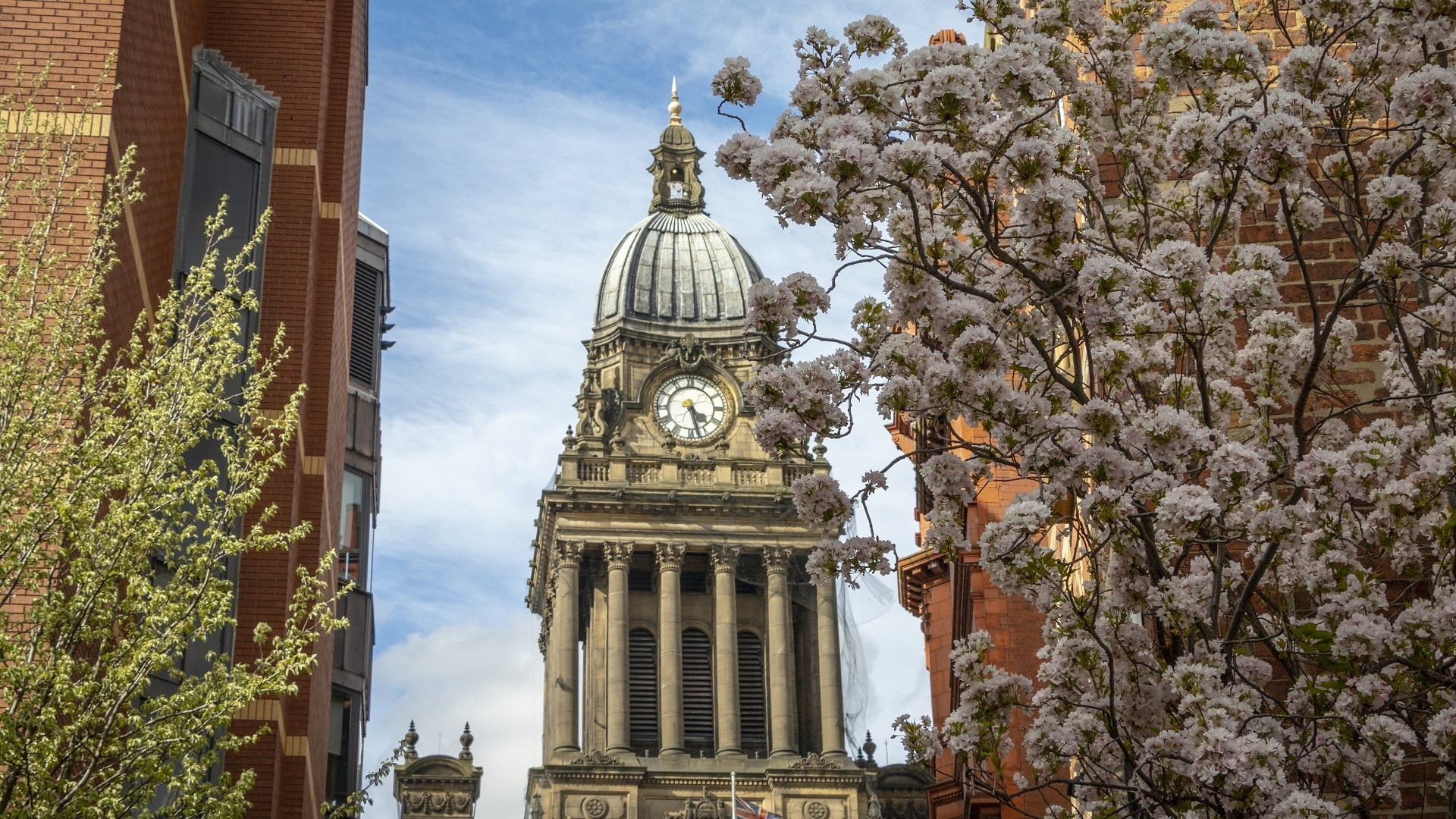
Blogs.
Leeds Self-Guided Architecture Tour
24th July 2020
From award winning buildings to the intricately beautiful Victorian arcades, here in Leeds we have an array of fascinating architecture to keep you amused for the day. With a blend of old and new, the architectural styles and buildings are captivatingly different but all equally as spectacular.
Take a look at some of the city’s architectural wonders at your own pace with this self-guided walking tour.
1. Leeds Central Library
In front of you stands Leeds Central Library, home to Leeds’ main public library services. Designed to complement the Town Hall to its left, this grand building boasts an Italianate façade in Yorkshire stone. Tucked away inside is the impressive Tiled Hall, now home to a café.
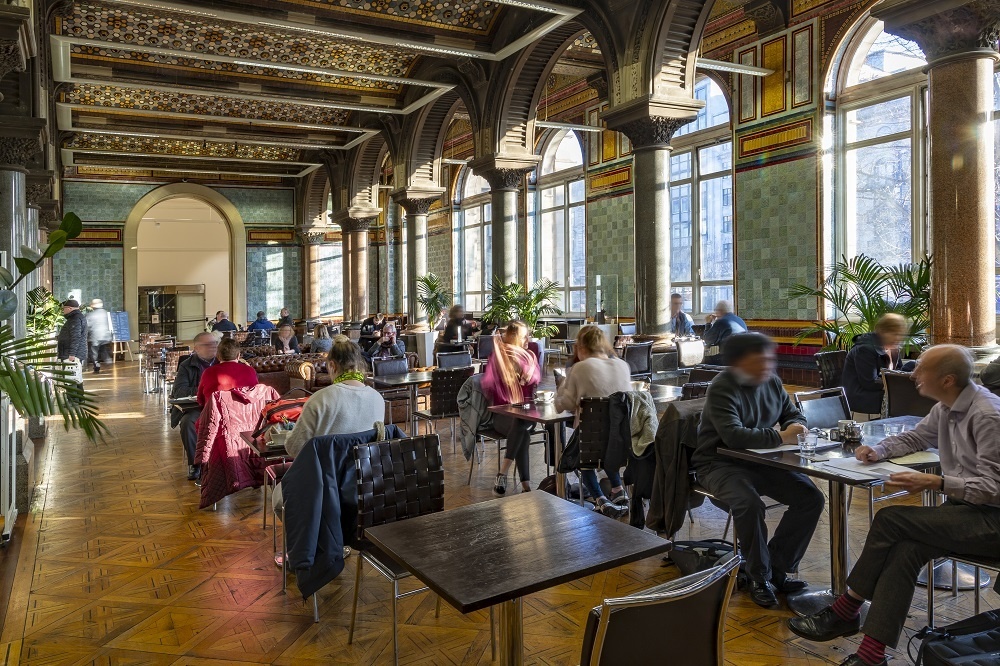
(Tiled Hall Café, credit Carl Milner Photography)
Cross over the road to the West to take in…
2. Leeds Town Hall
Designed by Leeds architect Cuthbert Broderick, Leeds Town Hall was built in 1858 and opened by Queen Victoria herself in the same year. It was the city’s tallest building when it was constructed, and remains one of the largest town halls in the UK standing at 68.6m (225ft high).
Walk round the back of the Town Hall and left down Great George Street. At the junction with Portland Street in front of you stands the Leeds General Infirmary.
3. Leeds General Infirmary
The original Victorian Leeds General Infirmary, now the Martin Wing, is a stunning example of Victorian Gothic architecture. This impressive site was completed in 1869, and included a Winter Garden, designed on the advice of Miss Florence Nightingale by renowned architect Sir George Gilbert Scott, famed for St Pancras Station and London’s Albert Memorial.
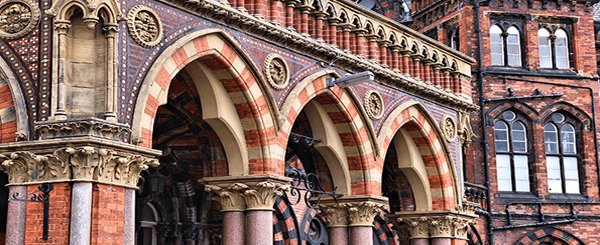
(Leeds General Infirmary, credit Lichfields)
Continue to your right down Portland Street and cross over onto Millennium Square.
4. Civic Hall
Dominating Millennium Square is Leeds Civic Hall, which took over from the Town Hall as the city’s main municipal building. Construction began in the height of the great depression in 1931 and utilised many who would otherwise have been unemployed. If you look closely, you can see two 2.3 metres high gold-leafed owls on top of its twin towers which are joined by four more owls on columns in Millennium Square.
Keeping the Civic Hall on your left, walk up to join Woodhouse lane, then continue North towards the universities.
5. Broadcasting Place
On your right you will see the distinctive Broadcasting Place. You’ll either love it or hate it but either way it will catch your eye! The rusty looking angular building is owned by Leeds Beckett University and has won awards for its fascinating design, beating Dubai’s Berj Khalifa to the title of ‘Best Tall Building in the World’. The structure is clad in Cor-Ten steel, which weathers over time giving it its distinctive red colour and its nickname ‘The Rusty Nail’.
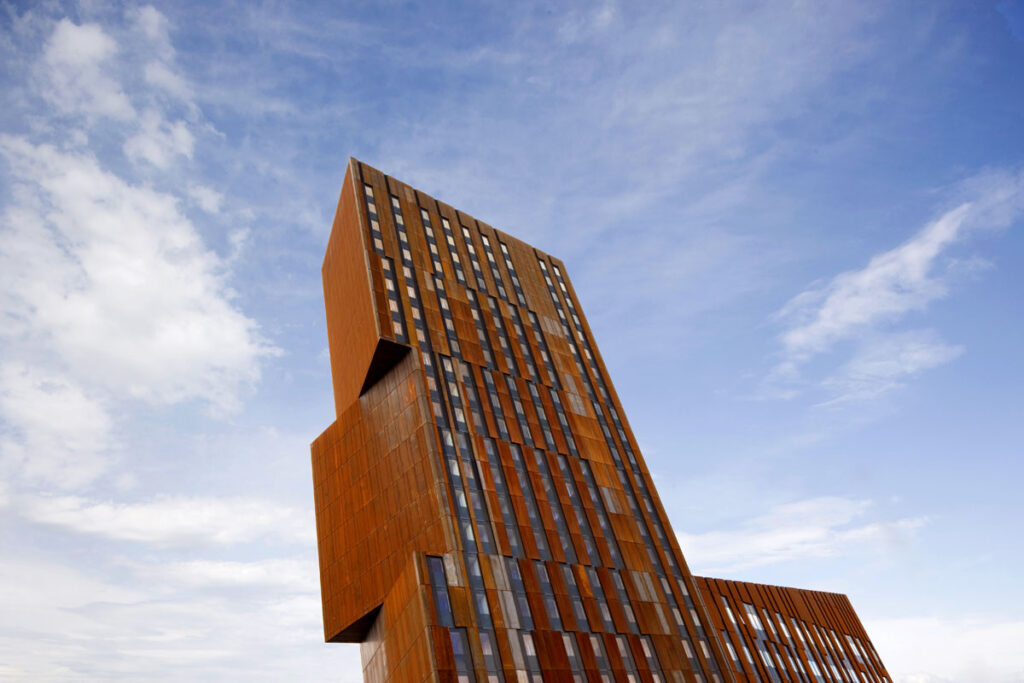
(Broadcasting Place, credit Cloud9)
Enter the Leeds University campus to your left at the ‘Discovery Way’ entrance, and follow the footpath to the end. Turn right on Willow Terrace Road passing The Edge on your left, then up the ramp to the right.
6. Roger Stevens Building
Set behind a water feature is another ‘marmite’ piece of architecture, Roger Stevens. This Grade II listed brutalist building was designed by the same architects that built London’s Barbican theatre: Chamberlin, Powell and Bon. The building’s futuristic looks even had it used as a backdrop for a Doctor Who episode.
Retrace your steps back to Woodhouse Lane and follow this road south until you reach Merrion Street. Follow Merrion Street down until you see a park to your right. Enter this green space and follow the footpath round to take in…
7. St John the Evangelist’s Church
St John’s is the oldest church in Leeds City centre, built all the way back in 1632-4, a time in English history when very few churches were constructed. Famed for its spectacular wood carvings, the inside is well worth a look if possible.
Continue through the church yard and exit onto New Briggate. Cross the road and look up at…
8. Grand Theatre
This distinctive theatre has been described as ‘probably the finest of its size in Britain’ and it’s not hard to see why! The unusual architecture takes inspiration from European churches and mixes Romanesque and Gothic styles, with the interior being just as striking as the exterior.
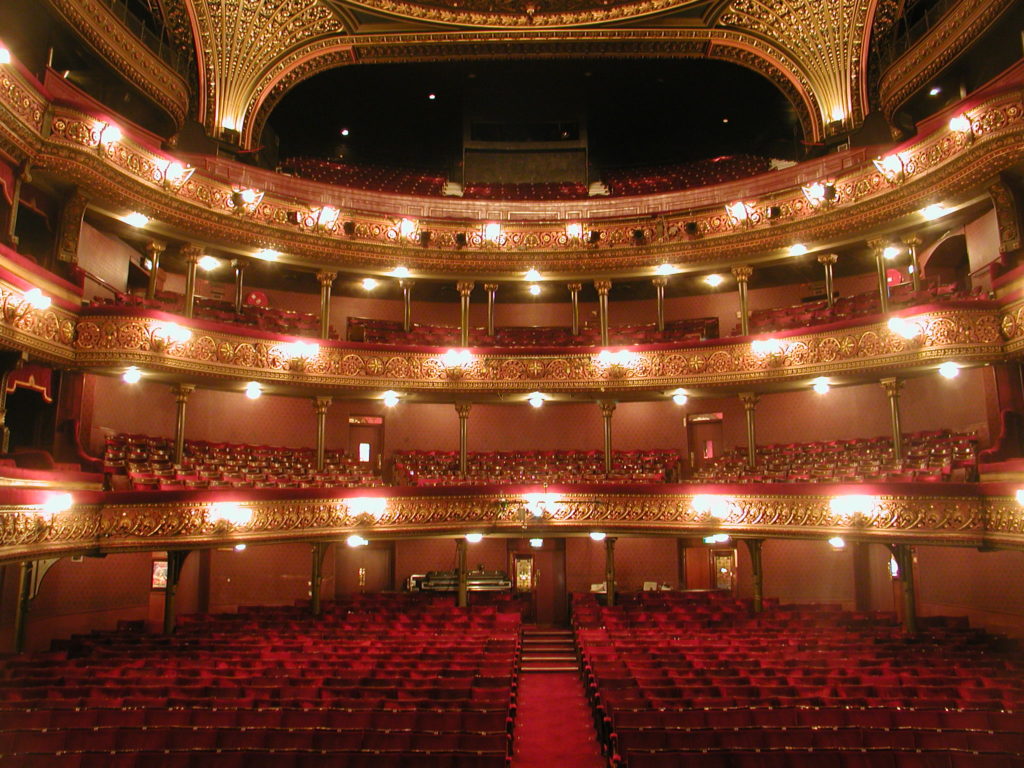
(Leeds Grand Theatre interior)
9. Grand Arcade
Adjacent to the Grand Theatre is our first example of Leeds’ spectacular Victorian shopping arcades. A great spot for independents, the Grand Arcade is over 100 years old and features an animated clock above its East entrance.
Walk down New Briggate and cross The Headrow to the city’s pedestrianised high street, Briggate. To your right, next to Starbucks, is the entrance to the next arcade on our tour.
10. Thornton’s Arcade
One of the first of Leeds’ arcades, the cast iron arches in this arcade feature decorative red winged lions. Another arcade to including an unusual animated clock, this one features characters from Sir Walter Scott’s Ivanhoe, with Robin Hood and Friar Tuck showing off their legs.
Exit Thornton’s Arcade at the opposite end, turn left and enter Queen’s Arcade on your left.
11. Queen’s Arcade
So called in honour of Queen Victoria for her Golden Jubilee. While you won’t find any more quirky clocks, Queen’s Arcade is another stunning example of a Victorian Arcade with ornate balconies and an intricate stone floor.
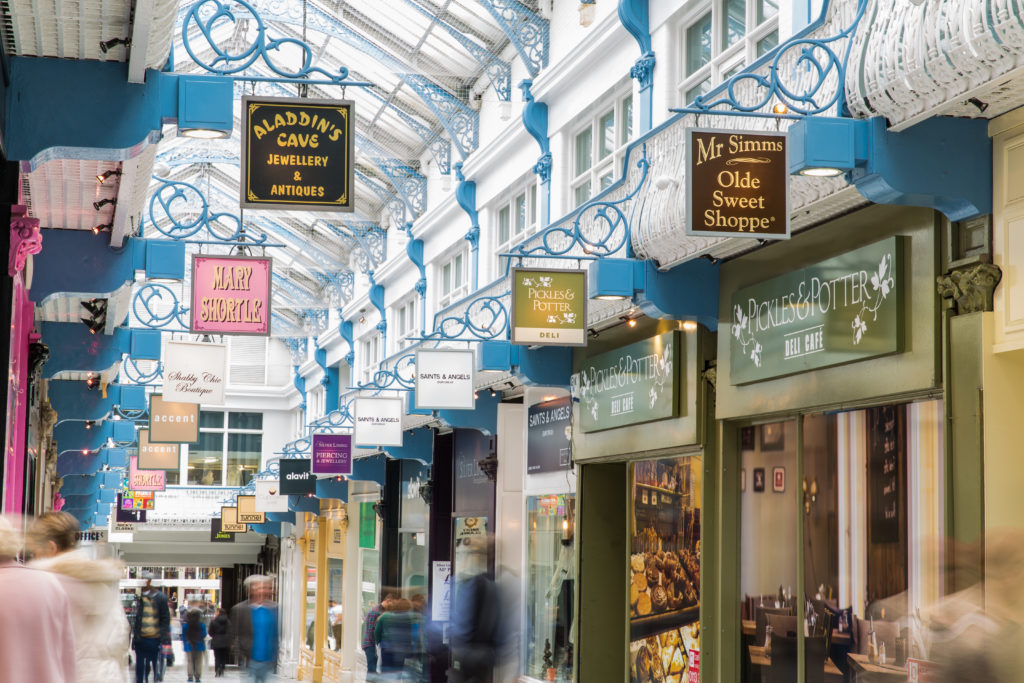
(Queen’s Arcade, credit Hannah Webster)
Exit back onto Briggate and follow the road down to your right. Pass over Commercial Street to your right and keep an eye out for the small alleyway called Turk’s Head Yard leading to our next stop, Whitelock’s. (between Carphone Warehouse and Virgin Money)
12. Whitelock’s Ale House
Whitelock’s, founded in 1715, stands out as the oldest pub in Leeds. Situated down one of the many alleys or ‘ginnels’ which extend off Briggate, its current interior dates all the way back from the late 1800s. The pub serves a selection of real ale and craft beers alongside fresh, locally sourced food.
Exit Turk’s Head Yard back onto Briggate and walk up back towards the arcades. Next door to Harvey Nichols is the entrance to our next arcade.
13. Victoria Quarter
Perhaps Leeds’ most famous shopping arcade, Victoria Quarter is packed with stunning architectural features amongst an exclusive array of stores. Above the widest arcade stands the largest stained glass roof in Europe, covering what used to be an open road. Wind your way left after Thomas Sabo to take in the ornate features of the County Arcade.
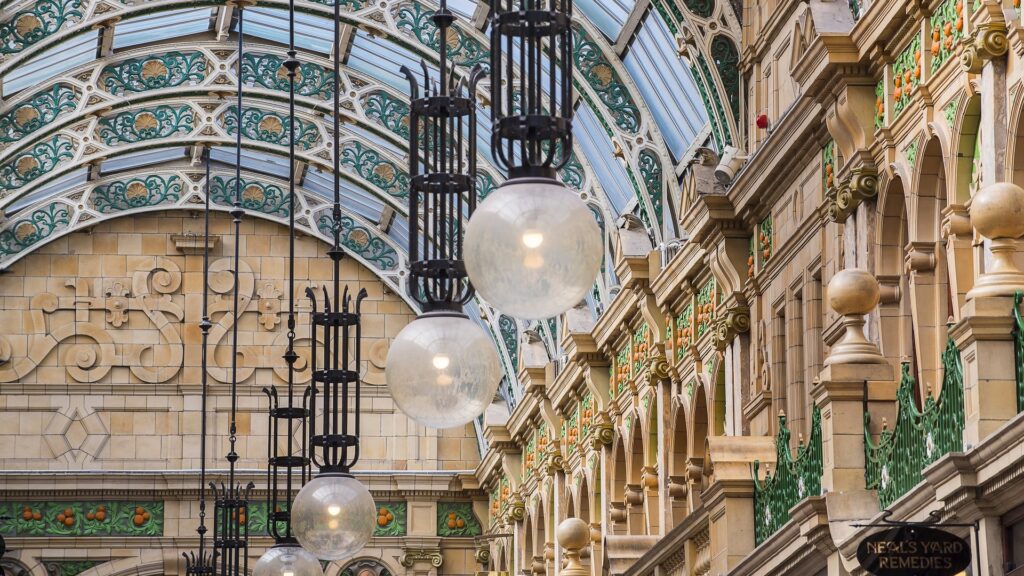
(Victoria Quarter, credit Giles Rocholl)
Once you have explored the Victoria Quarter to your heart’s content, exit onto Vicar Lane and cross the road and head East towards Victoria Gate.
14. Victoria Gate
Leeds’ newest addition to the selection of arcades is Victoria Gate. Opened in 2016 the design incorporates elements from the traditional Victorian arcades of the city and gives them a modern flair. The statement glass roof and granite herringbone floor give this arcade a seriously glamourous feel. Take a closer look at the bespoke pendant lighting – can you see the Yorkshire rose in the design?
Wander through the arcade and exit to your right onto George Street. Cross over the road and enter our next stop…
15. Kirkgate Market
As one of the largest indoor markets in Europe, Leeds Kirkgate Market has pushed many technological and architectural boundaries since it opened in 1857. Look up at the spectacular domed roof and ornate pillars and look out for the green clock in the centre of the main hall. Next to this you will find the M&S market stall, paying homage to its roots as a penny bazaar in this very market back in 1884.
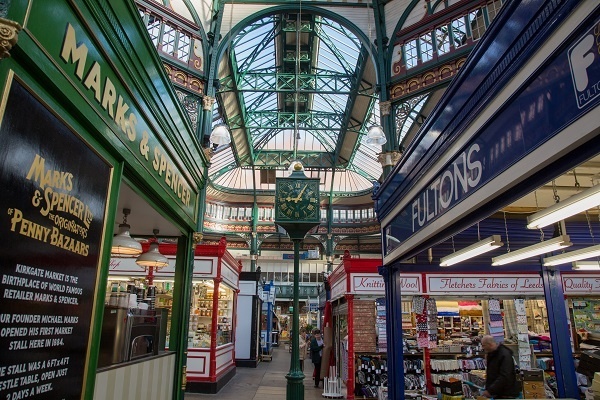
(Kirkgate Market, credit Leeds City Council)
When you have taken in the sights, sounds and smells, exit the market to the South West corner, cross Kirkgate (Leeds’ oldest street) and walk up Call Lane. To your left you will find…
15. Leeds Corn Exchange
Dating back to 1864, the Grade 1 listed Corn Exchange is one the finest buildings in the city. With its huge domed roof and intricate detailing, it is now the home of independent retail and food traders and a burgeoning creative neighbourhood. Step inside to truly take in this iconic architecture.
Round the back of the Corn Exchange on cobbled streets, pass under the railway arch and turn left onto The Calls. Cross over and continue down the Calls until you reach the imposing Leeds Minster.
16. Leeds Minster
Formerly Leeds Paris Church, Leeds Minster was consecrated in 1841 and is built in an imitation of 14th century English Gothic style. Inside the church the ancient Saxon Cross discovered on the site of the previous church building still remains as one of Leeds’ oldest relics.
Walk back up towards the Calls and turn left before Calls Landing. Walk down the cobbles and take the first right to cross the footbridge over the River Aire. Turn right and skirt along the river’s edge, past the large lily pond, following Navigation Walk round to Dock Street. Cross over Bridge End and follow Water Lane East to pick up the footpath along the river. Pick up Water Lane again as you cross Victoria Road with Bridgewater Place to your left. Keep following Water Lane past the Midnight Bell and The Cross Keys until you reach Marshall Street on your left.
17. Temple Works
Halfway down Marshall Street you will find the truly breath-taking Temple Works, a former flax mill. Finished in 1840, the façade is modelled after the Temple of Horus at Edfu, with dramatic Egyptian-inspired columns. The large factory behind was once the largest single room in the world. This one-of-a-kind building also contained the world’s first hydraulic life, which was developed to transport sheep to the roof. But why did they need sheep on the roof? The roof was covered in grass designed to maintain the temperature and moisture within the factory required to prevent the linen thread from drying out. Naturally the grass needed maintaining, hence the sheep.
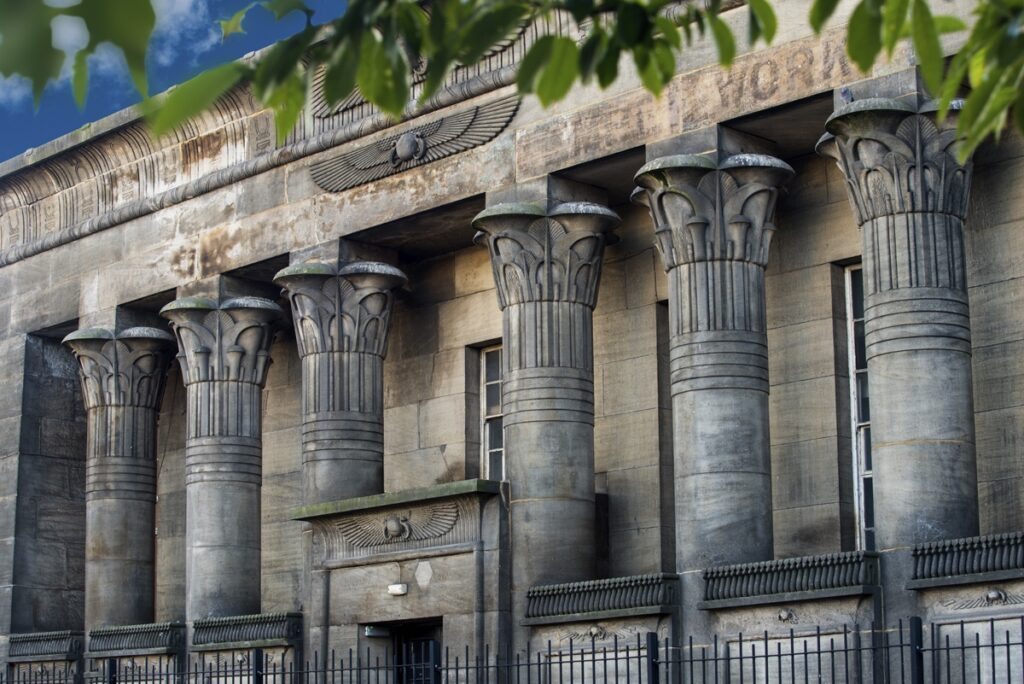
(Temple Works, credit South Bank Project)
Walk back up Marshall Street and Water Lane, and turn left onto Globe Road, where you can hardly miss the landmark towers of our next sight.
18. Tower Works
Another former factory, the three towers that give this building its name are all Italian inspired. The largest is based on Geotto’s Campanil’ in Florence, the smaller ornate one styled after the Venetian ‘Torre dei Lamberti’, and the third plain tower is thought to be based off a Tuscan tower house. These days the eye-catching structures lie in the heart of the South Bank regeneration area.
Join back onto Water Lane and take the first left up Wharf Approach. Cross over the Leeds Liverpool Canal and wind your way past Candle House and the Doubletree.
Walk up Neville Street under the railway arches and join New Station Street to your left. Pass Leeds City Station to your left and come out onto City Square. Continue past the Queen’s Hotel and Cross over Wellington Street in front of the Majestic Building. From here take a left down Quebec Street and follow this to the end.
19. Bank House
On the corner of King Street and Park Place is the divisive Bank House. This Grade II listed brutalist structure combines Cornish granite and bronze cladding. Its unusual layout where each floor sticks out above the one beneath it makes it a marvel of structural engineering.
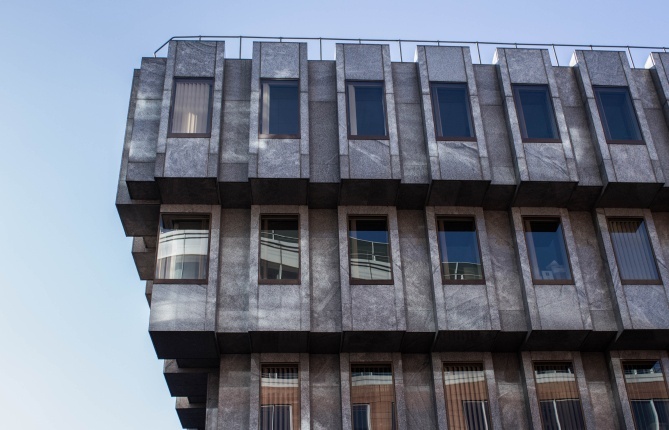
(Bank House, credit Brutalist Constructions)
Continue down Park Place and take a right onto Central Street, then take a left.
20. St Paul’s House
In front of you is one corner of the magnificent St Paul’s House. Built in a unique Hispano-Moorish style using local bricks, this building features intricate minarets on each corner. The ones currently seen are actually fibreglass copies, with the originals housed in Leeds Discovery Centre for safe keeping. Wander up St Paul’s Place to Park Square to continue marvelling at this magnificent structure, you could even bring a picnic.





